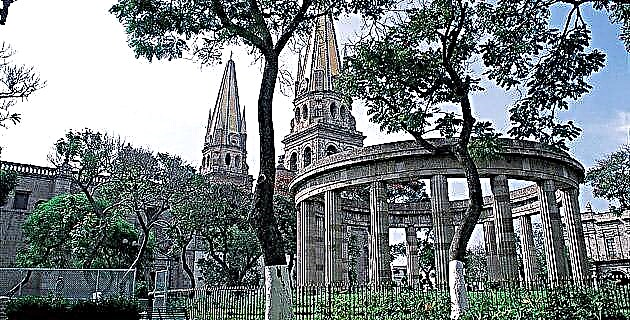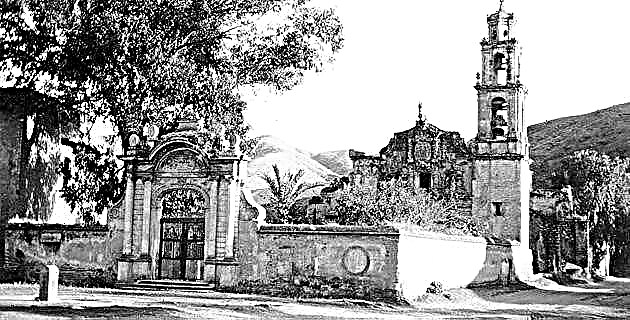
The town of Marfil, founded in 1556 (six years after the accidental discovery of the San Bernabé mining vein), is located approximately 6 km from the city of Guanajuato, declared a Cultural Heritage of Humanity by UNESCO a few years ago.
The town of Marfil, founded in 1556 (six years after the accidental discovery of the San Bernabé mining vein), is located approximately 6 km from the city of Guanajuato, declared a Cultural Heritage of Humanity by UNESCO a few years ago.
The founding of Marfil was simultaneous to that of the city of Guanajuato, and the economic, political and social activities of both populations are intimately linked throughout their history; in 1554 four camps or forts were installed, one of them being Real de Minas de Santiago Marfil; The other three were Santa Ana, Tepetapa and Santa Fe, currently all of them neighborhoods or towns located around the city of Guanajuato.
The fact that the town of Marfil is so close to the town has led to the fact that the historical importance of the site and its architectural monuments is sometimes ignored, or not properly valued, a circumstance that sometimes came to be assumed as such by its own inhabitants. The lack of historical memory of a community is, perhaps, the central factor that determines the conservation or neglect of architectural spaces for community use.
The temple of San José and Señor Santiago, located in the lower part, or Marfil de "below", is an example of oblivion but also, and most importantly, of recovery of the historical memory of the community, where the latter has been the central axis of the activities.
Marfil, the original settlement, occupied only the banks of the Guanajuato River, where the beneficiation farms were located for mineral treatment; its population, at the beginning of this century, oscillated between 10 thousand inhabitants. The construction of the temple of San José and Señor Santiago began in 1641, on the instructions of fray Marcos Ramírez del Prado, bishop of Michoacán, jurisdiction to which Marfil belonged. The temple is one of the oldest buildings of this type (even in the city of Guanajuato), although it was not until May 1695 that its construction was completed, according to Don Lucio Marmolejo in his Guanajuato Ephemeris.
It is necessary to highlight that Bishop Ramírez del Prado was the same one who began the construction of the Morelia cathedral in 1660, ending until the next century, in 1744. However, there are no more data on architectural or stylistic influences received from the builders or the bishopric of Michoacán, although it is possible to suppose them.
At the end of the 19th century and the beginning of the present, Marfil went through a difficult and confusing stage: technological advance in the treatment of minerals, the introduction of the railroad to the city of Guanajuato (with the obvious disappearance of the station previously located in Marfil), and two strong floods in 1902 and 1905, disrupted the life of this town and that of its inhabitants.
Given the above circumstances, the Parish Temple of Marfil had to change its location to a higher part, to the northwest of the previous headquarters. This, coupled with a noticeable drop in population density, resulted in Marfil being considered a “ghost town”. It is from that time that the temple of San José and Señor Santiago ceased to be the center of attention of the community. Witness to the time of the founding of the town and the city of Guanajuato itself, the property has great architectural importance, since it shows the construction techniques and aesthetic trends of the moment, as well as being an inexhaustible source for the knowledge of culture and of the forms assumed by the specific community that made it possible. Some buildings in the Guanajuato state cannot be explained or understood in their proper dimension without first having analyzed this example.
The temple of San José and Señor Santiago, is preceded by an atrium which is entered through a neoclassical portal, whose enclosure is a depressed arch with outstanding ornaments and moldings; on both sides there is a pilaster and a half sample of Ionic style. The four supports support an entablature whose cornice becomes a pediment over the door. In correspondence with the axes of the half samples and the pilasters, oval cartouches were placed on basements, and in the center a body with a concave profile was raised, topped with two scrolls and a vase.
The front of the baptistery consists of a single body with a semicircular arch in the main access bay, with diamonds and panels inscribed in the voussoirs; The phytomorphic ornamentation that covers the spandrels starts from the key, and niches are located on both sides. On the entablature there is an open pediment and an enormous chalice develops on its tympanum, the spherical part of which seems to close the pediment and above it, protected by a large canopy, a dove and a background glow, as a representation of the Holy Spirit.
At present, the original cover is located at the entrance of the patio of the School of Industrial Relations, towards the patio of the Law School, both institutions located in the central building of the University of Guauajuato; The main portal that the temple currently has is not the original, since after the sealed change, a replica of the original was placed in the 1950s.
Towards the southwest, another cover of great importance appears, which was also detached and placed at the University of Guanajuato in the 1940s. At that time, the removal of the covers was justified by the desire for conservation and recovery, since the temple was almost completely abandoned, since the community and its religious guides practically did not use it for any activity, except on rare occasions. Thus, the passage of time and the action of the meteorological agents, in addition to certain acts of vandalism, caused the deterioration of the property.
The plant of the temple is of a Latin cross, very elongated, with two chapels attached in later times: the minor, is a quadrangle attached to one of the arms of the cross and the other, is a space that has the same length of the nave. , from the facade to the transept.
The set is complemented by some annexes that supported the administrative activities of the parish headquarters. On the northeast side façade there are several buttress arches, whose formal and structural characteristics, as well as their slenderness, their sui generis beauty and their baroque style make them unique in the region and, probably, beyond. In the middle of the last decade, as part of an academic exercise, three students of the Master of Restoration of Sites and Monuments, taught at the Faculty of Architecture of the University of Guanajuato, developed an intervention and recovery project. This consisted of making the temple a sociocultural meeting point, as it was in its origins. The main obstacle we faced was the non-existent, or barely tenuous, historical memory of the community.
Consequently, the first actions (already in the early nineties), before the strictly technical ones, focused on constant dialogue with the members of the community. A key instrument was the participation of those in charge of the temple, who have been elements of link and impulse for the awareness of the community to recover an important legacy of our ancestors.
Likewise, the support of various personalities of the community was decisive for the continuity of the project. But the most important thing was the participation of children, young people, the elderly, women and men from Marfil and surrounding communities dependent on said parish, who with their work have made possible the restoration of the San José and Señor Santiago temple and its annexes and, therefore, hence, the rescue of the common historical memory of said monument.
During the works, original traces of the atrium and the basement of the fountain that presided over the plaza located in front of the temple have been discovered, as well as the limits of the property. On the other hand, all the areas have been cleared (which implied the manual hauling of hundreds of tons of silt); the existing cracks in walls, vaults and other elements have been sealed and consolidated, such as the main tower that threatened to collapse and it required special restructuring work.
Now it is possible to admire, for example, the unique side arches for their style and treatment.
The atrial façade currently shines in all its splendor, thanks to the excellent work of the first level workforce of the artisans of the community itself. Likewise, the reconstruction of the side portal (a true copy of the one that is still in the University of Guanajuato), the incorporation of some images that had been located in other points of the community itself, the well in front of and to one side of the access The main work, and a large number of small interventions, are evidence of the extraordinary work carried out by the artisans of the community, which together allow us to talk about the recovery of the building.
Today the property has an important use for the community: as a religious, cultural, social center and even as a setting for some events of the International Cervantino Festival.
The rescue of the temple of San José y Señor de Santiago de Marfil, in Guanajuato, is an example of how a community aware of its historical past, can recover with its own effort a cultural wealth for itself and, therefore, for the country .
Source: Mexico in Time No. 8 August-September 1995











